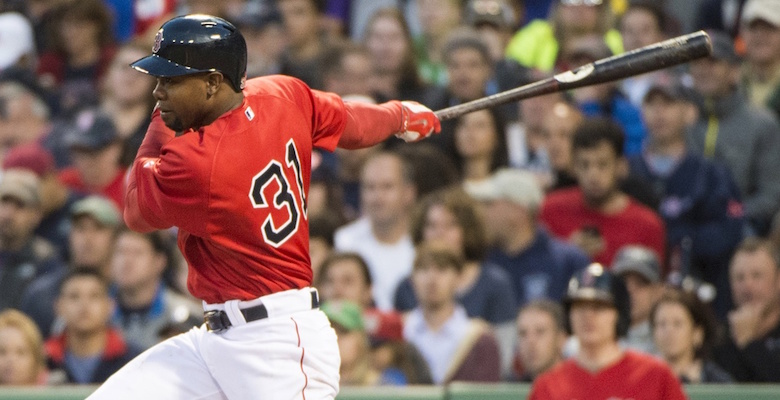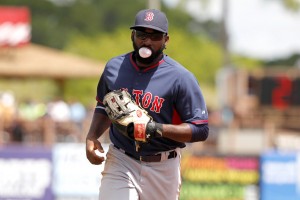Last week, the Boston Red Sox traded for outfielder Alejandro De Aza. This is almost humorous, because coming into the 2015 season, the only sure thing in Boston was that the Sox had too many outfielders, and no place to play them all. Pundits were certain the team might trade away outfield talent, lest they be forced to stuff talented young players like Jackie Bradley Jr. and Rusney Castillo into sacks and ship them off to Pawtucket.
As you probably know by now, the team started the season with an injured Castillo and, choosing an outfield rotation of Mookie Betts, Shane Victorino, Hanley Ramirez, Daniel Nava and Allen Craig, packed up Bradley and mailed him off to Rhode Island. In many ways this made sense: Bradley had options and he’d disappointed offensively in 2014. The team’s second-most talented young center fielder was named in far too many offseason trade rumors, but ultimately, the team stood pat on their depth.
Moving into June, things have happened, as things are wont to do. Allen Craig has been worse than anyone could have anticipated, and my father told me that he has been sent away to a farm upstate where he can run around and play. In the least surprising development since the sun rose this morning, Victorino got injured. Down two outfielders now, you’d think that the next logical move would be to call up Bradley along with Rusney. Alas, JBJ has only received six games and 13 plate appearances with the big club.
Somehow, Carlos Peguero showed up on the Red Sox roster instead of Bradley. Peguero, formerly of the Rangers, Royals and Mariners, can hit a little, but isn’t the backup center fielder that anyone wants. But after Peguero wasn’t cutting the mustard, the Red Sox went out and gave up a real, live prospect (Joe Gunkel) to get Alejandro De Aza.
De Aza’s a good outfielder, a solid major-league regular for the last few years. BP puts his career True Average at .266, which puts him close to league-average, and his defense is decidedly average. The question isn’t why a team would acquire De Aza — the question is why this Red Sox team would acquire De Aza when they already have a player like Jackie Bradley Jr.
Bradley hasn’t been a very good hitter in his time in the major leagues, but in Pawtucket this year, he’s positively raking. He’s got a .388 on-base percentage and a .486 slugging percentage, and while that’s due to regress a bit, one doesn’t have to squint to imagine a world where he’s an okay hitter in the majors. Bradley’s defense is world-class, so even if he doesn’t hit the way the team might like, he could still be as good overall as a player like Alejandro De Aza.
To me, the question is why. Why did the team go out and acquire another outfielder when they had a perfectly good one waiting in the wings? I’d like to review a couple of possibilities:
The Red Sox Do Not Believe in Jackie Bradley Junior
This is the worst, most reactionary reason why the Red Sox haven’t brought Bradley to bear. If the Red Sox didn’t believe in Bradley, the team would’ve shipped him off to another team long ago. They would have never called him up in the first place, or traded him for pennies on the dollar to one of the dozens of teams who could use a premium defensive outfielder. This is a talk-radio reason, and not worthy of a big league front office that makes rational decisions.
The Red Sox are Showcasing Bradley for a Trade
While possible, I think we’ve come to the point where front offices aren’t going to be confused or convinced by a very short-term, small-sample performance when trading for players. While it is possible that Jackie Bradley’s long-term value to the Red Sox will come as part of a trade package, it seems unlikely that the team would hold him down in Pawtucket, where he’s succeeding, so that he doesn’t embarrass himself at Fenway and diminish his value.
General managers just don’t think that way anymore. I think. Front offices are way smarter than we give them credit for, and we give them plenty of credit.
The Red Sox Prefer Offense to Defense in the Outfield
Anyone who’s seen Hanley Ramirez play left field can attest that this might be the case. Perhaps the Red Sox want to improve the team’s offense more than the team’s defense, and perhaps they figure the best way to do that is to add the “safer” bat of De Aza. And make no mistake, De Aza’s bat is a safer bet.
Last year, JBJ was a terror at the plate of Freddy Kruger-ian proportions. He hit for no power, struck out constantly, but also failed to reach base a lot. In the minors, Bradley has been a good bet for on-base percentage, but the risk present in his bat is real. But without a doubt, the thing that makes Bradley a valuable big-league contributor is his glove. It’s not just good, it’s great. All the major defensive metrics peg him as a win or two in pure defensive value, even in just two-thirds of a season last year.
On the other side, De Aza’s other skills vacillate, but his bat has been steady. His defensive and baserunning numbers shift from year to year … but those numbers are often seen as less reliable than offense. Whereas Bradley is a question mark on offense — a question mark that may lean towards below-average — the Sox can rely on De Aza to provide unsexy but effective numbers in the lineup. Maybe that’s just their preference at this point?
Jackie Bradley Jr. is Better Served By Having Regular Plate Appearances
Player development is a very real thing, though it’s often overlooked in sabermetric circles. While I personally couldn’t identify what it is that Bradley Jr. still needs to improve upon, the Red Sox player development staff may have something in mind. And one thing I do know, from my background as an instructional designer, is that it will be a heck of a lot easier to improve at a given skill with regular, applicable practice, versus intermittent practice.
If Bradley did come up to the big league team, it would be hard for him to get regular playing time when the struggling Betts and Castillo need the same. Add in Hanley to the outfield calculus, and Bradley might not be receiving regular starts even before accounting for the other “regulars” on the bench. It’s perfectly reasonable to think that Bradley will continue to improve at Pawtucket with regular playing time, versus languishing on the big league bench. It’s a judgment call, but a fair one in my view.
The Red Sox Believe that Alejandro De Aza is a Better Baseball Player Today
This may actually be the reason that speaks loudest. De Aza is a pretty steady commodity, as far as available outfielders go. His year-to-year numbers have been roughly consistent: a healthy mix of batted ball ability and double-digit homer power makes him just dangerous enough as a corner outfielder. He’s an average baserunner and defender … he’s basically the picture of a second-division starter in a corner outfield spot.
Jackie Bradley, for all his defensive wizardry, may rely just a bit too much of defense to make the case for a comparable WARP to De Aza overall. If you’re not too confident in Bradley’s defensive numbers, and you’re worried that he won’t hit well enough to carry the day, it makes sense to think that De Aza is simply the better outfielder over the course of the season.
Maybe when we get down to it, choosing De Aza over Bradley is less about Bradley, and more about De Aza. Unlike Peguero (sorry, buddy), De Aza is a real, serviceable starting outfielder this year. Perhaps we need to think of it this way: Bradley isn’t necessarily being held down, it’s De Aza who’s rightfully being held up. Bradley may still be part of the plan, but there’s no shame in going with someone who’s closer to a sure thing.
Top photo by Gregory Fisher/USA Today Sports Images


Another reason could be that in the actual environment with many players underperforming the expectations the FO didn’t want to risk getting JBJ in that situation, since he struggled so much last season and maybe needs to stabilize his approach some more?